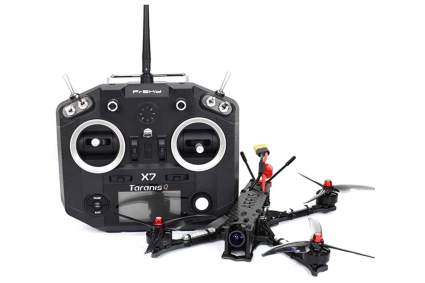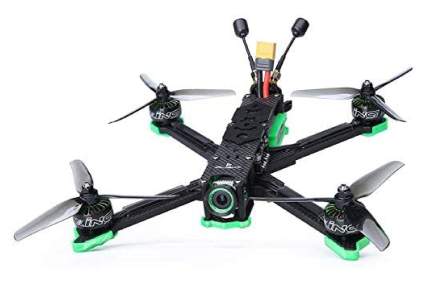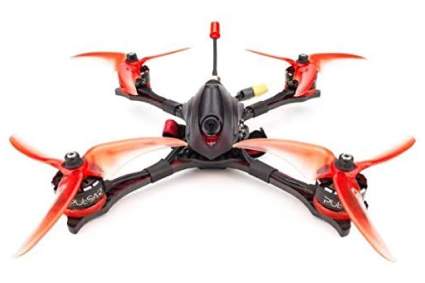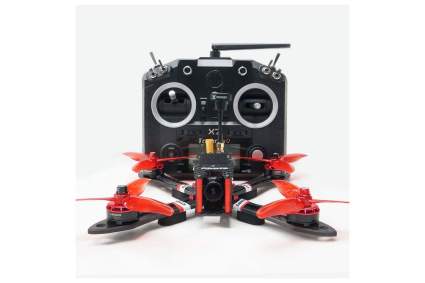
Drone racing is seeing a meteoric rise in popularity partly due to the formation of professional groups such as the Drone Racing League and competitions like the Dubai World Drone Prix. The latter of which saw a 15-year-old kid take home a $250,000 cash prize.
Like racing simulators, racing drones give you the thrill of high-speed competition without the need for super expensive equipment or potential dangers. So browse through our favorites below and get yourself

|
Amazon Customer Reviews
|
Price: $329.00 Shop at Amazon | Shop now Read our review |

|
Amazon Customer Reviews
|
Price: $1,049.99 Shop at Amazon | Shop now Read our review |

|
Amazon Customer Reviews
|
Price: $335.00 Shop at Amazon | Shop now Read our review |

|
Amazon Customer Reviews
|
Price: $179.00 Shop at Amazon | Shop now Read our review |

|
Amazon Customer Reviews
|
Price: $409.98 Shop at Amazon | Shop now Read our review |
-
1. Walkera F210 Professional Racer
Pros:- Fantastic camera
- Powerful motors
- Night Vision
- Comes with DEVO 7
Cons:- FPV headset not included
- Price
- Plain-Looking
The Walkera F210 Professional Racer has a unique 700TVL night vision camera that allows you to practice at night, and it has a wide 120-degree viewing range. It comes with a reliable Devo 7 transmitter. It’s admittedly one of the strangest, bulkiest-looking racing drones to buy (even though it’s a 210 class), but don’t let its appearance fool you — this thing can buzz around with the best of them.
The Walkera F201 features a truly innovative design that’s incredibly fast and one of the best plug-and-play solutions on the market right now. It’s driven by four powerful 2500kv brushless motors that push it to the limits, giving it incredible speed and zip. When you apply some pitch, it’s incredibly fast. This drone is a perfect entry-level professional racer and, like the Blade Mach 25, it also has a carbon fiber frame that’s super-strong.
An observation: that ridiculous-looking mushroom antenna in the back may be an eyesore, but it was placed there to provide superior transmission capabilities, making it less likely that you’ll lose contact with your drone in the middle of a race. Because that’s no fun for anyone.
Buy the Walkera F210 Professional Racer here.
-
2. Arris Dazzle 5-Inch FPV Racing Drone
Pros:- Price
- Sturdy Design
- Standard Connectors
Cons:- Not RTF
- Doesn’t come with everything you need
- Plain-Looking
The pre-assembled Arris Dazzle 5-Inch FPV Racing Drone is one of our top picks for the best racing drone available. Not only does it come in at a feasible price point, but it also has a 1200TVL camera with zero delay and a FrSky Q X7 radio and receiver. You’ll be able to really raise the stakes with this drone as part of your racing team.
The build is very strong and durable, thanks to the high-strength carbon fiber frame, and it uses standard connectors so that it’s easily modified. The drone comes fully assembled and tuned by Arris’ professional technicians; simply bind and fly. Specially designed for freestyle flying, the drone features a low gravity center, a 4mm double lower plate, and a 5mm arm design.
-
3. iFlight Titan XL5 HD 6S Racing Drone
Pros:- Features DJI first-person-view system
- 720p video shown at 120fps
- Nice performance and weight distribution
Cons:- Firmware installation may be a hassle
- Somewhat expensive
- No additional cables or accessories are included
Built with rugged flight toughness in mind, the iFlight Titan XL5 HD 6S Racing Drone will take a beating and still come back for more. The weight distribution on this drone is nicely balanced but it’s certainly not lightweight. The Xing 2208 motors run smoothly with a grounded feel to the flight characteristics.
The DJI first-person-view system allows for some great sightseeing that’s easy and open. The quadcopter build with its x-geometry is clean allowing for higher performance. The twin bug-like antennae look pretty cool as well.
If you’re a first-time drone flier, you may want to do some research on how complicated it is to set up this drone. Reports of wonky firmware applications before a flight are commonplace with this racing drone but not impossible. Also, GPS lock before a flight can be cumbersome at first but once that’s taken care of (with six or more satellites needed before the first flight), operation shouldn’t be an issue.
Find more iFlight Titan XL5 HD 6S Racing Drone information and reviews here.
-
4. EMAX Hawk Pro Racing Drone Quad
Pros:- LED Pulsar motors
- FRSKY compatible
- Speeds up to 100 MPH
Cons:- QC issues from the factory; check your components before flying
- Promoted for beginners but it's really an intermediate-skill flyer
- Will take a beating but not too many
EMAX markets the Hawk Pro Racing Drone Quad as appropriate for beginners but be careful: this thing can zip. EMAX first introduced a drone called the Hawk 5 that established a good baseline that facilitated a solid racing experience. With the Hawk Pro, they’ve raised that baseline.
This racing drone utilizes a lighter canopy, a more aerodynamic profile that allows faster speeds, and an improved power-to-weight ratio. Along with those amenities, the Hawk Pro retains rigidity and durability to handle any flight situation. The slim design of the Hawk Pro also provides a mounting system that allows for a customized flight experience.
The FPV transmission system and camera have been upgraded from the Hawk 5, so pilots will be able to fly with more ease, navigating terrain with a clear view. The power system consists of Mini Magnum III power stacks paired with a Pulsar brushless motor system and Avan Scimitar propellers.
Find more EMAX Hawk Pro Racing Drone Quad information and reviews here.
-
5. Arris X220 V2 220mm RC Quadcopter
Pros:- Solid build and great flight balance
- Radio and drone paired and ready right out of the box
- LED status indicators on rear of drone
Cons:- Very little documentation included
- Some reports of signal interference from 100 feet away
- This drone isn't for beginners
This is an assembled ready-to-fly version of the Arris X220 V2 220mm RC Quadcopter and the kit includes a QX7 radio set and a high-quality 4S 1,500mAh Lipo battery. Each of the X220 units has been calibrated and pre-flown before shipping.
The symmetrical X design frame is made of total carbon fiber with some alloy parts which makes the drone lightweight and durable. A chamfered edge design on the arm gives this racing drone a sleek look at rest and in flight.
The 2300KV brushless motor is specially designed for high-performance FPV racing. The centrifugal fan design optimizes heat dissipation for longer life. For safety, the X220 features an integrated battery warning buzzer, allowing the pilot can set the threshold using the Betaflight adjustment software.
There are reports online about the Arris X220 inexplicably dropping out of the sky into a failsafe landing after a few minutes and around 100 feet away. This may be a firmware update issue since none of the reports about this issue date later than 2019 so just be aware.
Find more Arris X220 V2 220mm RC Quadcopter information and reviews here.
How Do I Get Started in Drone Racing?
The sport of first-person view quadcopter racing is still relatively new, so now's the perfect time to begin flying. But just like any other sport on the planet, racing drones requires patience, practice, and a (healthy) budget depending on how deep you want to get.
Off-the-shelf drones, while still awesome, simply aren't going to bring home trophies or (better!) cash prizes. While you could use consumer-grade quadcopters to race your friends or local groups, FPV racers sold at places like Target and Wal-Mart aren't competitive.
However, if you're looking to get started in drone racing, toys like those found at the big box stores or Amazon can be very useful. For less than $200, you can find fast drones that will allow you to familiarize yourself with the basics.
Quadcopters are weird little machines and they fly differently than hobby airplanes and helicopters. When you first start flying drones, you'll undoubtedly crash a few times. That's okay. Because drones are typically very light, they won't damage easily. However, practice as much as you can.
Still, you should stock up on extra propellers. And because flight time is typically limited to under ten minutes per charge, you should pick up some additional batteries, too. You'll soon find out that there is no shortage of fun accessories to buy for your new hobby.
You may find once you get into flying drones that taking photos or airborne videos is more your thing. That's okay, too! Just understand that those types of low-and-slow drones are very different than racing drones.
How Much Does It Cost to Get Into Drone Racing?
So, you've put in the time and you're ready to actually race drones? Cool! As stated above, there is no end to the gear you can buy when racing drones. To start, plan on spending at least $1,000.
That may sound like a lot but besides the drone itself, a racer will need a radio controller, FPV gear in the form of goggles or a monitor, batteries, chargers, and maybe a road case to carry it all to and from the races.
That's all just to start. Once you get into racing, you will experience more than a crash or two. You'll have to stock up on propellers, FPV antennae, and repair tools such as a good soldering iron. $2,000 is probably not a bad starting budget for a competitive drone pilot beginner.
Most of the winning drones in the upper echelon of the racing leagues are handbuilt by their owners. Racers customize their drones more than a little. Like other motorsports, racing teams are forever looking to tweak and adjust their machines in order to gain that edge.
So this means out-of-the-box drones, even expensive ones, aren't going to help you win races. Start small with toys and get good at flying, move up the ladder to more professional quadcopters, then move toward building your own. All of that is, of course, going to eat into your other discretionary budgets.
To build your skills, you should also consider getting a simulator for your PC or Mac. There are several good ones that will work with your radio controllers like FPV Freerider and Velocidrone. These video games will keep your skills honed and your reflexes sharp.
How Fast Can a Racing Drone Fly?
Most of the best racing drones around will exceed 75 miles per hour and some can get to around 120 miles per hour. That's great but drone racing isn't typically about drag racing. What's more important is maneuverability and pilot skill.
Drone races usually take the form of a meandering course that winds through a large area with obstacles as well as gates that the little machines must travel through. This means while speed is crucial, characteristics like lift power, response time, and stability are even more so.
And don't forget about durability. You will crash. A lot. That means the smaller and lighter your little drone is, the less likely serious damage will sideline you from racing. That said, count on replacing more than a few propellers during the course of your racing career.